Access More Boat Tests
Already have an account? Login
Offshore Yachts 54' Pilothouse (2022-)
Brief Summary
Offshore Yachts' new 54' Pilothouse is a long-range cruising yacht designed for a couple to manage comfortably. She comes with two or three staterooms and is powered by twin 715-hp Cummins QSM11 diesels.
Specifications
| Length Overall |
57' 3" 17.5 m |
|---|---|
| Beam |
15' 10" 4.82 m |
| Dry Weight |
60,000 lbs. 27,215.54 kg |
| Fuel Capacity |
1,000 gallons 3,785.4 L |
| Water Capacity |
300 gallons 1,135.62 L |
Engine Options
| Std. Power |
2 x 715-hp Cummins QSM11 diesels |
|---|
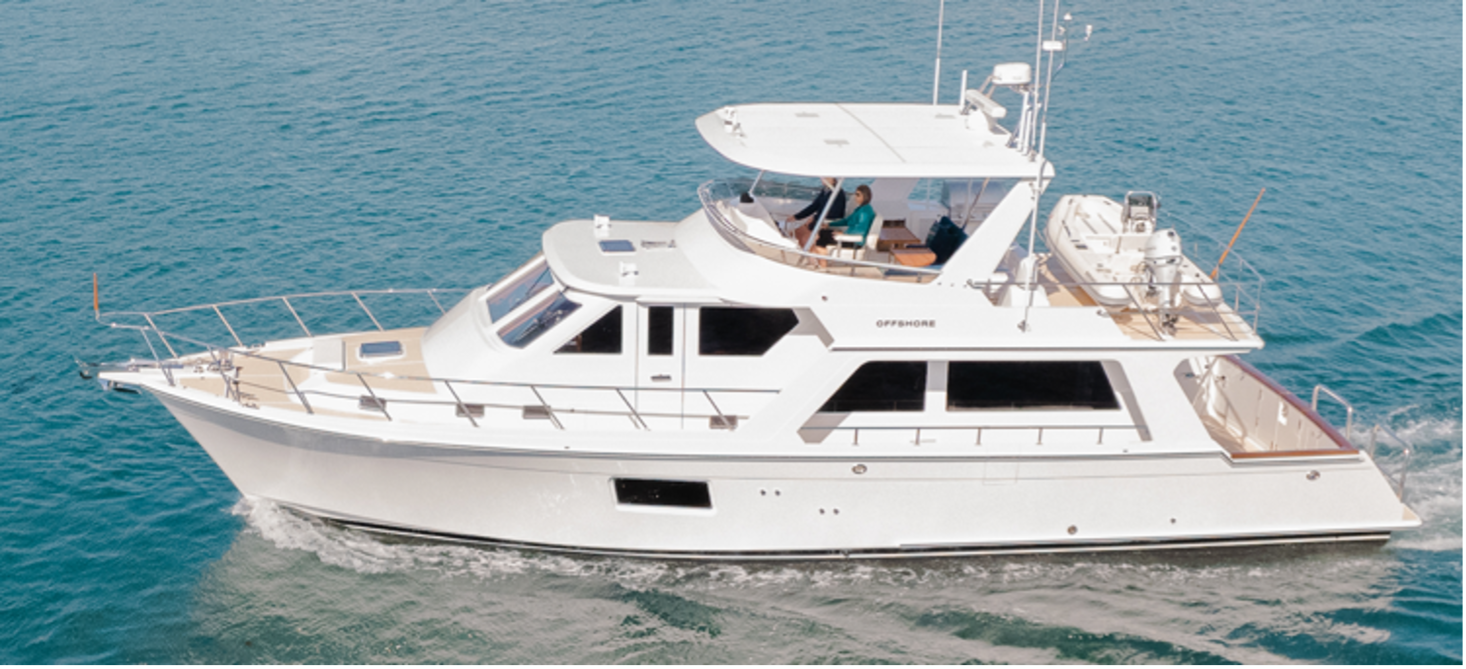
Report by Eric Colby
Mission Statement
Offshore Yachts’ mission for the 54’ Pilothouse is straightforward and basic: build a cruising pilothouse-type yacht that is easy for a couple to operate without additional crew and keep everything as gremlin-proof as possible.

Major Features
- Full-length keel with an extension to improve directional stability and protect the propeller
- 1,000-lb. hydraulic rotation, telescoping davit on aft flying bridge boat deck
- Marine Air 58,000 BTU A/C system
- Two Stidd 500-200 captain’s chairs at lower helm
- 12-kW Northern Lights Generator
- Seatorque M4-275 enclosed shaft system with Aquamet 22 HS shafts
- ZF Joystick maneuvering system with i-anchor
- Three joystick stations
- American Bow Thruster 220/4.5’ (1.37 m) hydraulic stabilizer system with pto
- American Bow Thruster 25-hp hydraulic bow/stern thruster with pto
- Maretron tank monitoring system
- Maxwell 3,500-lb. (1,587.57 kg) windlass w/three station controls.
- Deluxe Turnkey Décor package including exterior cushions
- Revere Crewsaver 6-person Type 1 ISO liferaft
Offshore Yachts 54’ Pilothouse Construction
The 54’ has a cored (high-density Gurit 100 PVC foam) hull, including the bottom, and a vinylester skin coat with epoxy bottom paint. All thru-hull fittings and underwater penetrations are surrounded by solid fiberglass and vacuum bagging is employed for the main components of the hull, boat deck and hard top. Vinylester resins are incorporated below the waterline. Otherwise, the construction seems to be standard hand-laid fiberglass and polyester resin.
She has a full-length keel with keel protection to help protect the props, which are in pockets to reduce draft, and may slightly improve efficiency. The bow compartment has a watertight hatch, and her engine room has a smooth polyester painted surface.
Stern to Stem Inspection
Starting at the stern, the 54’ Pilothouse has a non-skid swim platform. There are two removable stainless-steel rails plus pop-up cleats and a boarding ladder. There is also a rope ladder for emergency re-boarding. To help with cleanups, there’s a dockside freshwater connector and pressure regulator. Open the double transom doors before stepping up into the cockpit to give guests in the salon outstanding aft views. The captain also has improved views of the stern when docking.
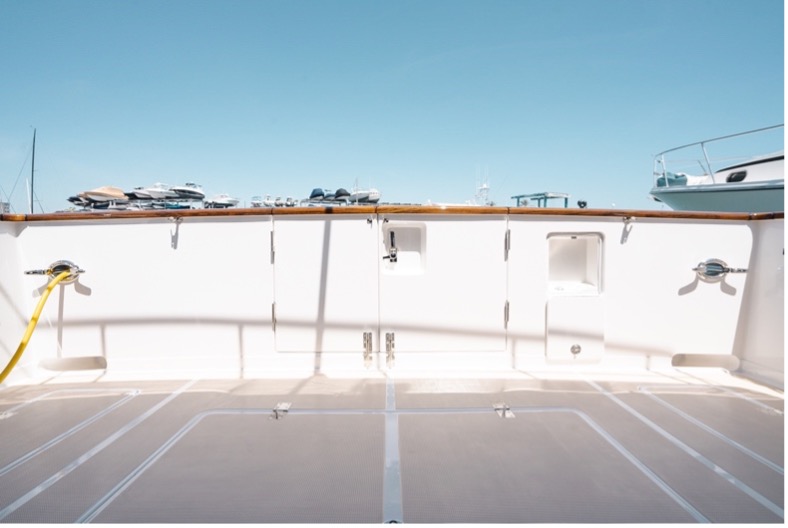
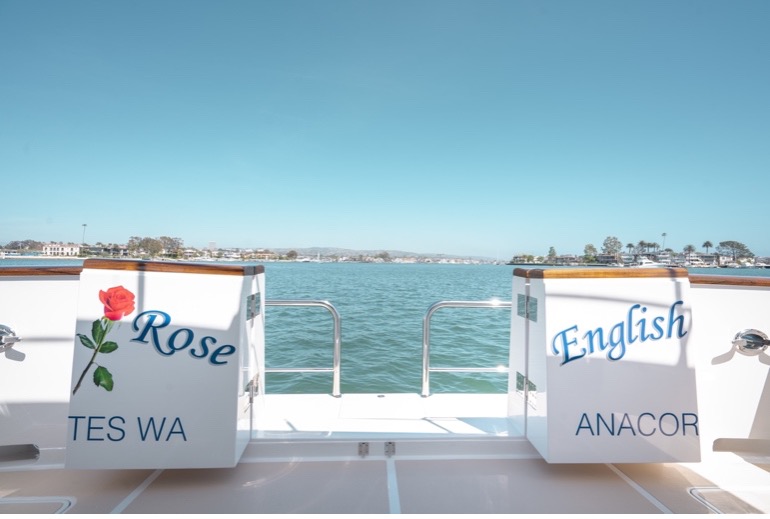
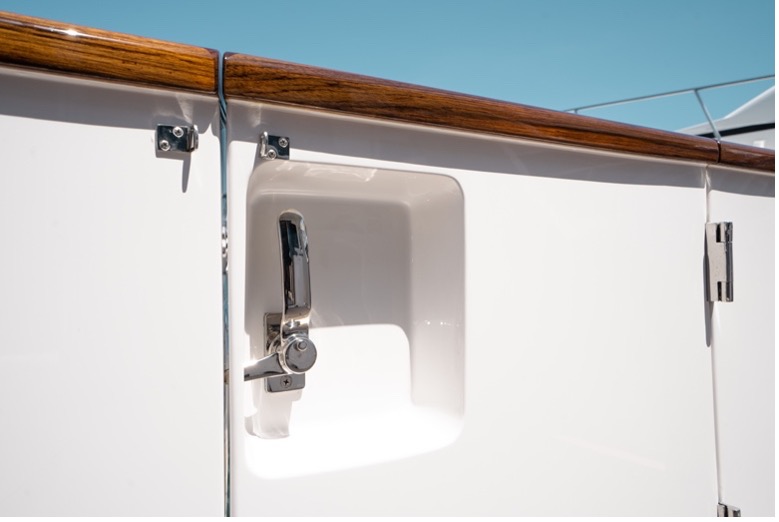
The Cockpit
The deck is covered in an easy-to-maintain nonskid. The area is left open for portable furniture. They can be stowed in the lazarette below. Forward to port is a cabinet with a hinged top that opens to reveal a standard sink and there’s storage in the base that can be occupied by optional refrigerator or icemaker.
To save space, Offshore positions the flying bridge ladder facing outboard to starboard and angles it for a comfortable climb. This is also safer in a sloppy sea than a vertical ladder facing forward. To the right of the ladder is the cockpit control station with shift/throttle levers, a JMS joystick, rudder indicator and engine start-stop switches.
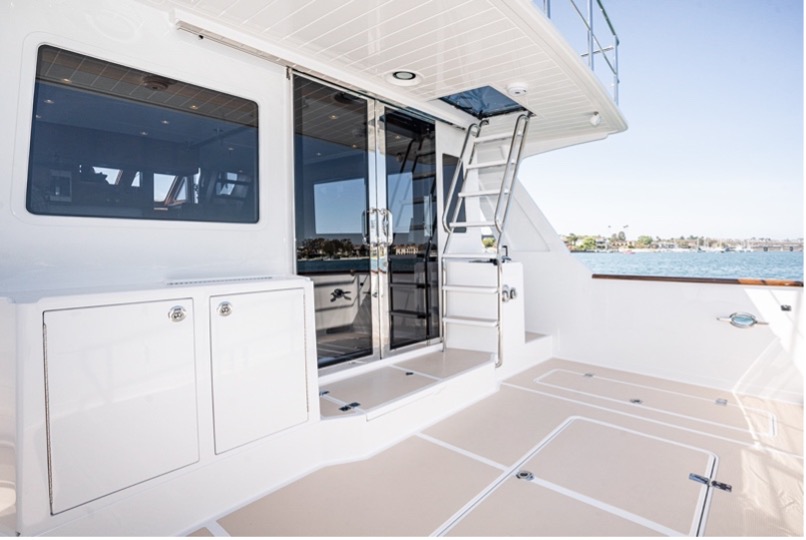

For easy cleanups, there’s a high-pressure freshwater washdown and hand-held shower in the cockpit. An electric hatch in the center provides access to the lazarette where an owner or tech can check on the batteries, hydraulic systems and other equipment.
Side Decks
Steps on each side of the cockpit lead up to the covered side decks. There are tall bulwarks and the flying bridge hangs over to provide protection from the elements. There are raised stainless-steel rails that start at the pilothouse doors and run all the way to the bow. They flare out slightly to make passage more comfortably. In addition, there are (2) hull boarding doors located midships for easy boarding regardless of slip configuration. The deck is symmetrical.
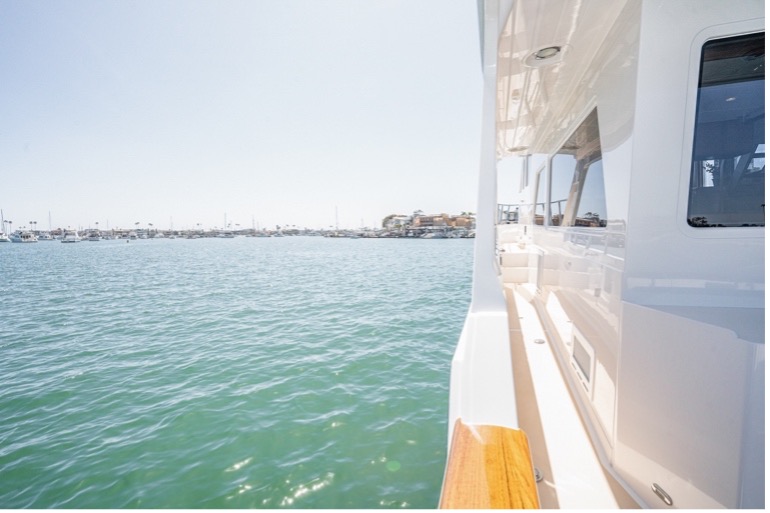
The Bow
The bow is primarily designed and set up for tending to lines and ground tackle, although there is a small bench-style lounge. The Maxwell windlass is on a raised section of the deck and the stainless-steel anchor deploys via a chute integrated into the pulpit. There’s a deck hatch for the forward stateroom on the trunk cabin.

The Flying Bridge

Back down the side decks to the cockpit and the flying bridge can be accessed via a ladder in the cockpit or from the pilothouse. We like this access because the owner/operators can reach the flying bridge without using the aft vertical ladder. This arrangement has several advantages: it is safer, easier to climb because there are half as many steps and is handy to the lower helm if something goes on the fritz in either location.
To port abaft the twin, Pompanette AS21 helm chairs is a J-shaped lounge that wraps around two small tables. To starboard is a bar with a sink and Isotherm 85 refrigerator and the grill is aft on the boat deck.
The upper helm has space for twin multifunction displays in the center and smaller items like a rudder position indicator, autopilot and the like on the vertical upper section. Up top, the compass is in line with the stainless-steel destroyer-style wheel. In the flat ahead to the steering wheel working left to right are the VHF radio, accessory-switch panel, toggles for the bow and stern thrusters and the digital Twin Disc shift-throttle levers. A venturi-style windshield is supported by a stainless-steel frame. and
Overhead, the flying bridge lounge and helm are protected by a hardtop equipped with lights. Isinglass can be fitted to make this a three-season venue.
The Boat Deck. This area also has a 1,000-lb. (453.59 kg) telescoping Steelhead davit with hydraulic rotation for hauling and launching a tender.
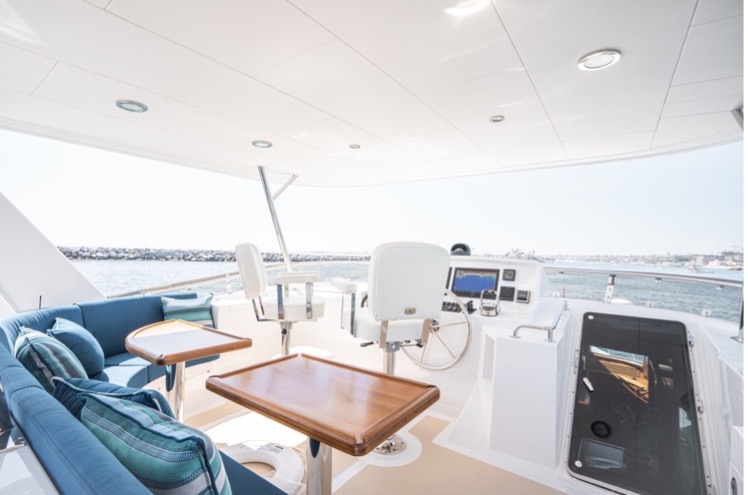
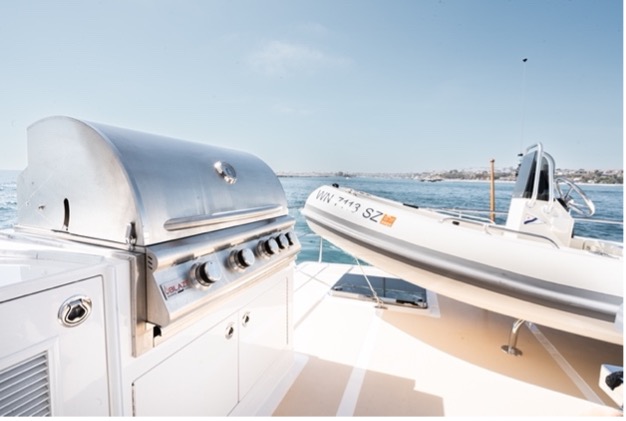
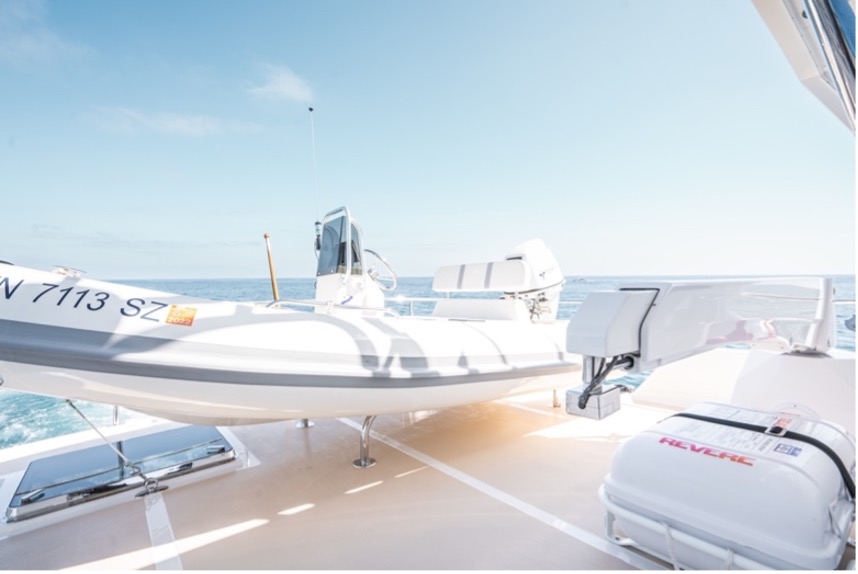
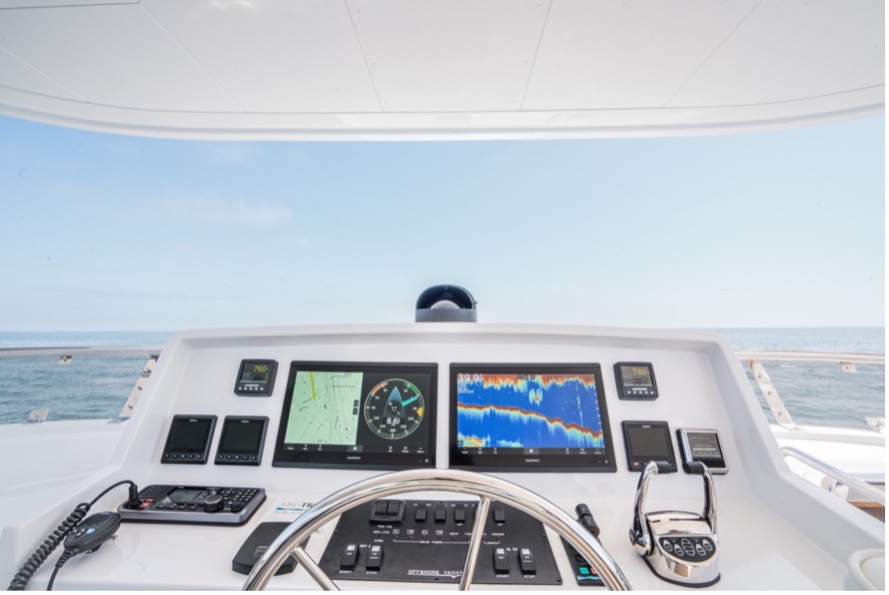
The Pilothouse
Sticking with the operational systems, a hatch alongside the upper helm to starboard leads down to the pilothouse.
The upper helm comes standard with the same gauges as mentioned above, plus an iPad with full systems schematics, manuals and other information. There’s also an in-dash display that shows system readiness. A 5.7” (14.48 cm) Maretron monitor provides levels for fuel, water and holding tanks. The captain and a companion travel in Stidd 500-200 helm chairs finished in Ultraleather and matching powder-coated bases.
Abaft the lower helm is a raised L-shaped settee with an adjustable high-low table that converts to a berth. There’s storage above the lounge and to starboard. A U-Line refrigerator is in a cabinet in the counter base.
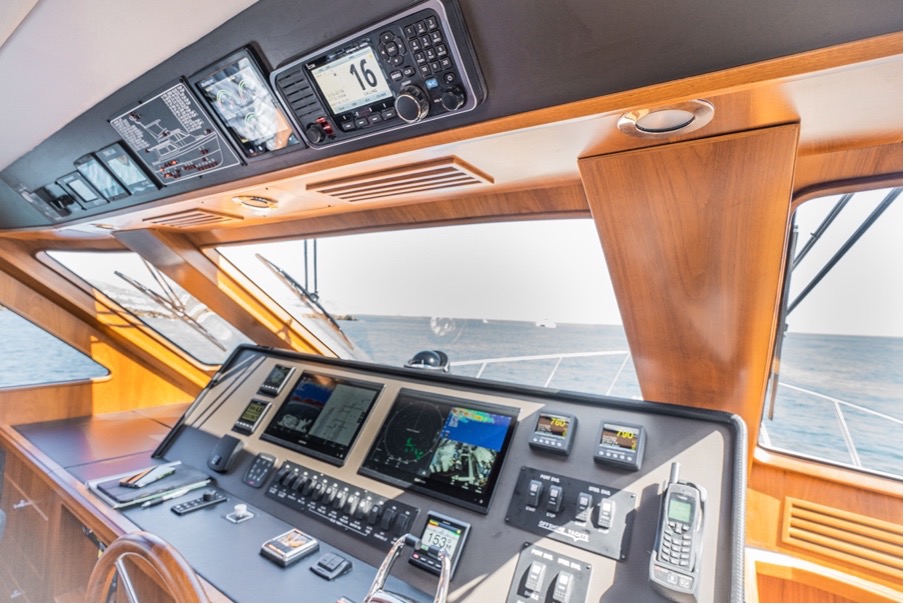

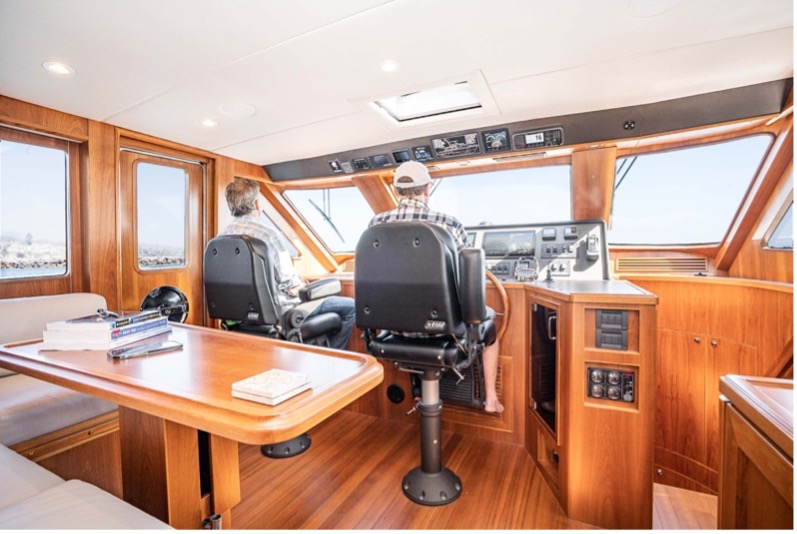
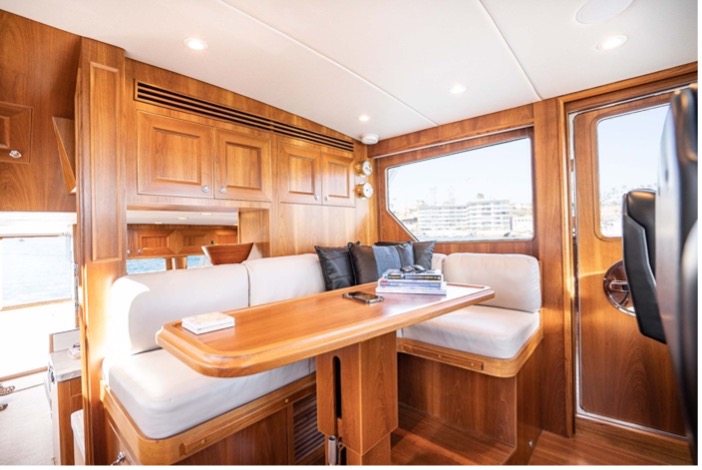
The Galley
Moving aft from the pilothouse to the salon, the galley is at the bottom of three steps to starboard. There’s a large window that bathes the granite countertops in natural light. There’s a single stainless-steel sink with a Grohe faucet and an Insinkerator disposal. For appliances, Offshore Yachts uses U-Line refrigeration, a Force 10 oven and cooktop, a GE trash compactor and a stainless-steel microwave/convection oven. Drawers and cabinets are lined with Formica.
The counters are granite or quartz backed by aluminum honeycomb to reduce the weight by 80%.
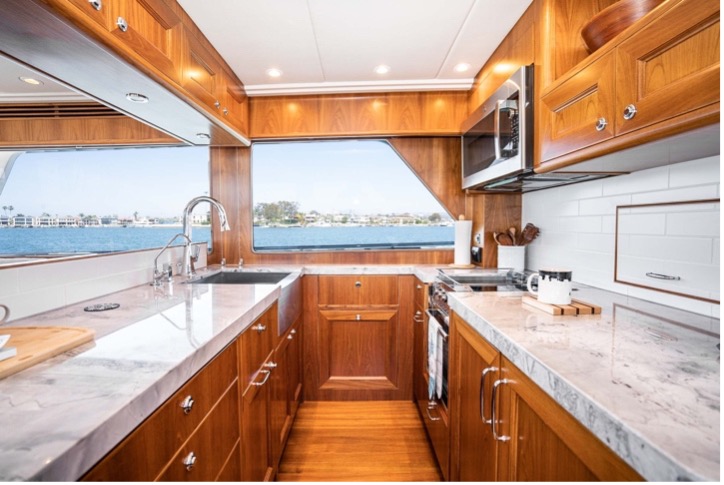
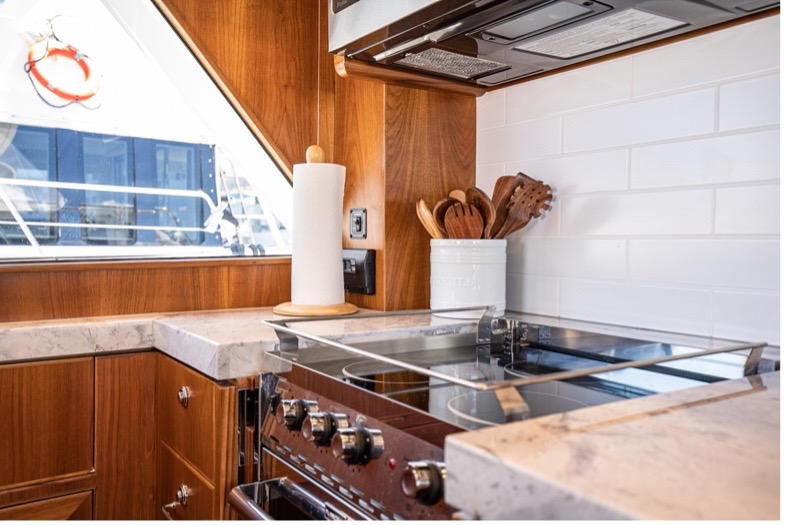
The Salon
The leading edge of the galley abuts an L-shaped lounge to port and free-standing chairs to starboard. A table with folding leaves is positioned for use by guests on the port lounge and a multi-drawer cabinet. There’s a teak and stainless-steel rail running down the center of the upholstered overhead.
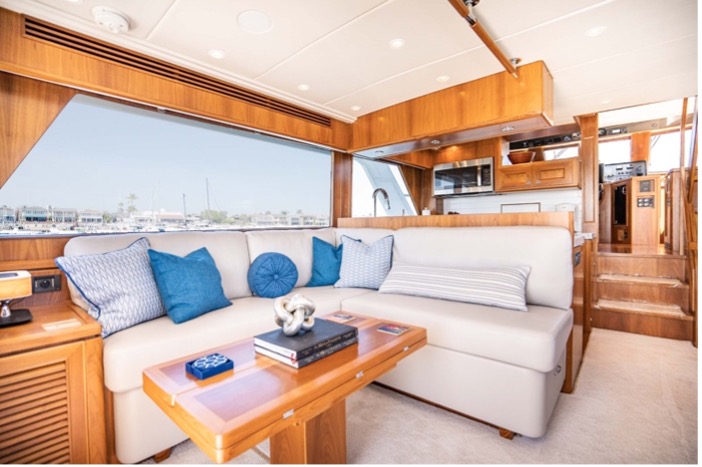
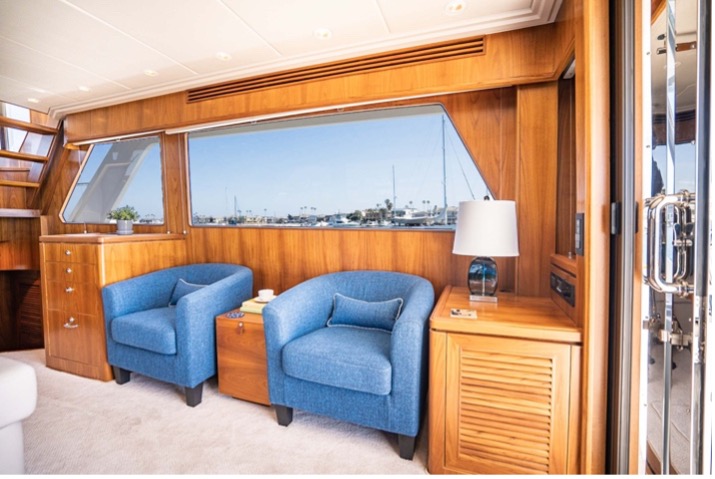
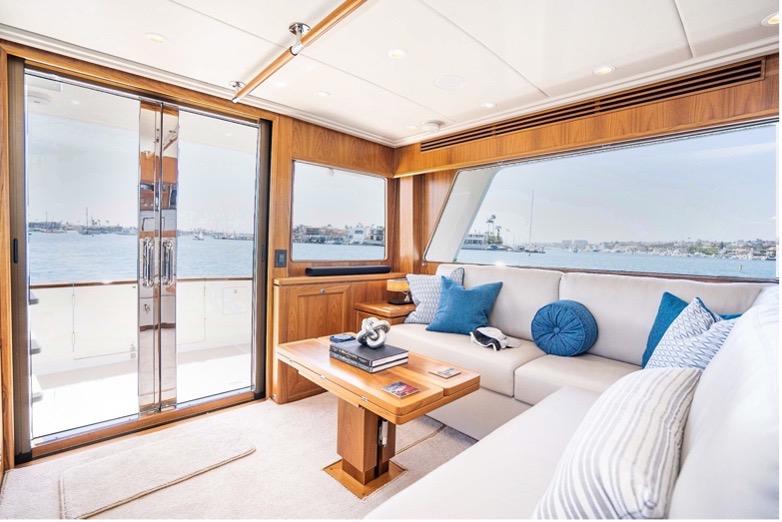
Offshore Yachts 54’ Pilothouse Accommodations Deck

The Owner’s Stateroom
If an owner prefers, he/she can choose private access to each of the boat’s staterooms or additional starboard to storage in the master. The cabin has a queen berth with drawers in the base and cedar-lined hanging lockers and a 43” (109.22 cm) Samsung TV. The en suite head comes with a solid granite or marble head countertop, a seat in a choice of the same materials in the shower and Grohe faucets, towel bars and rings. The separate shower has a frame-less glass door and ventilation.
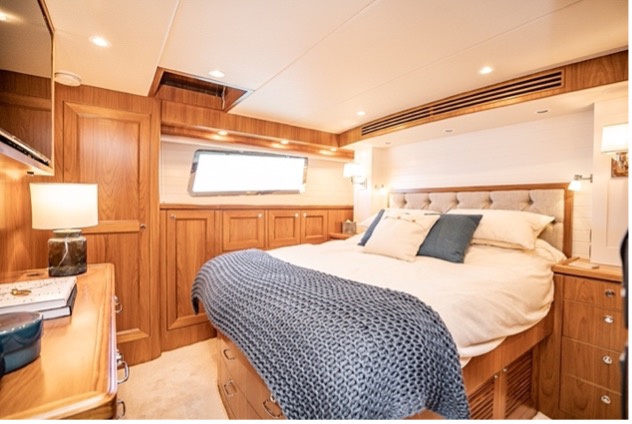
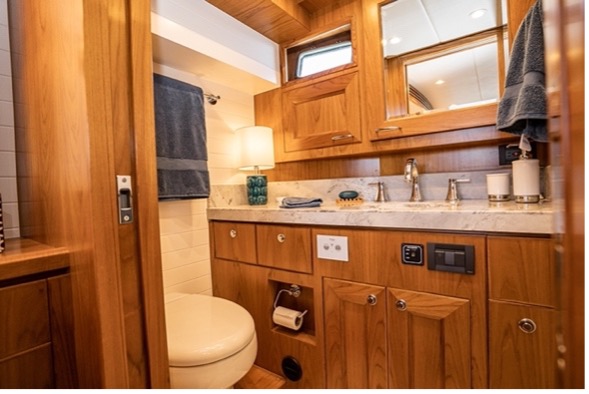
VIP Cabin
Offshore uses what it calls a queen-sized berth in the forward VIP quarters. It raises to access storage in the base and has cedar-lined hanging lockers. The VIP head has the same materials and fixtures found in the master with a separate shower. For emergency exits, VIP has an overhead escape hatch with an Oceanair sliding screen.
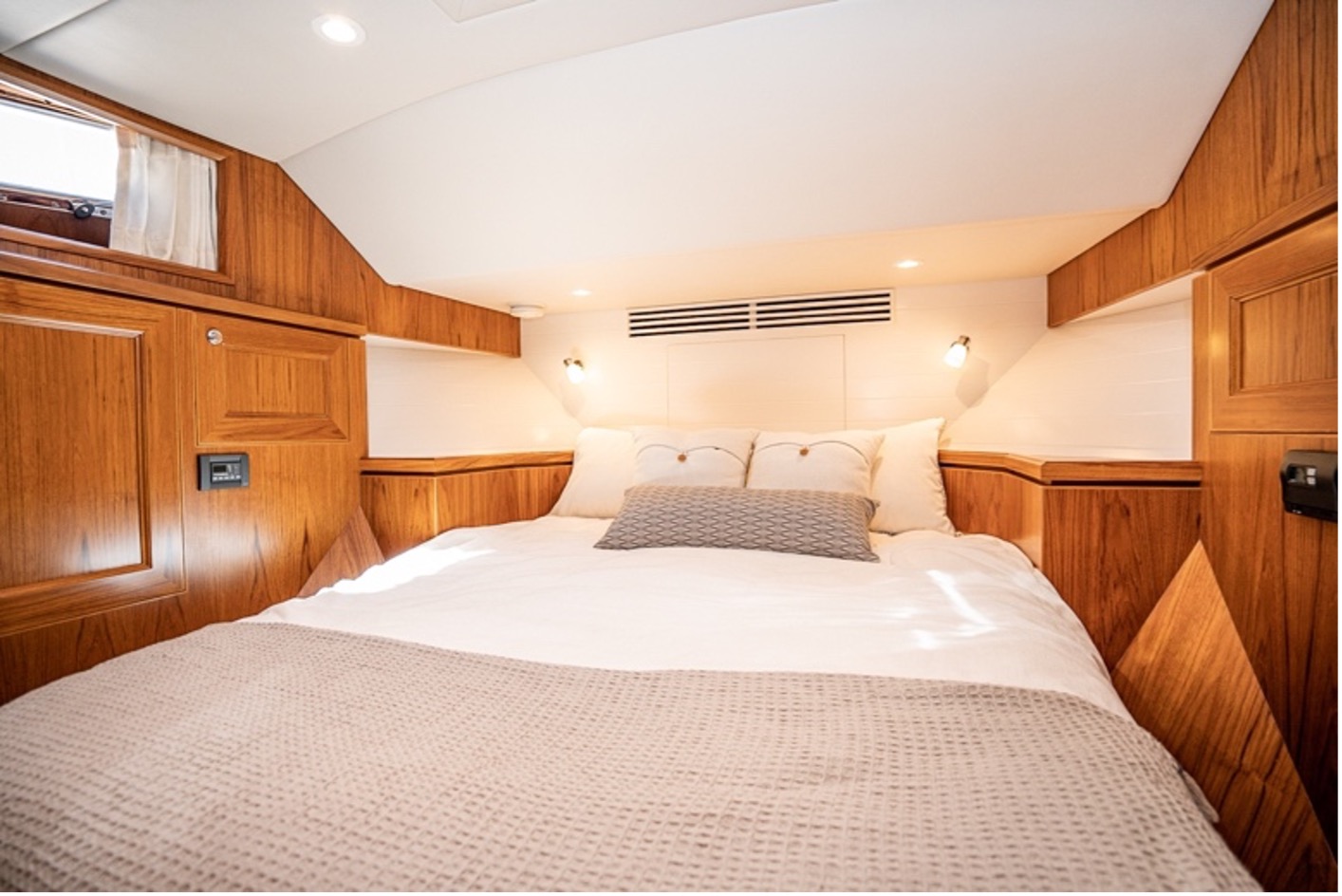
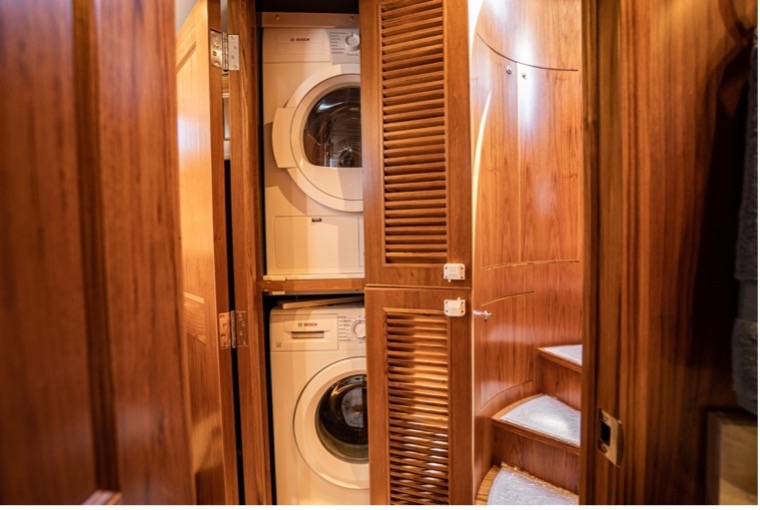
Engine Room
The in-deck hatch in the salon forward of the double doors to the cockpit provides access to the 54’ Pilothouse’s engine room. Walking surfaces are covered in nonskid vinyl and polyester paint is used throughout for a finished appearance.
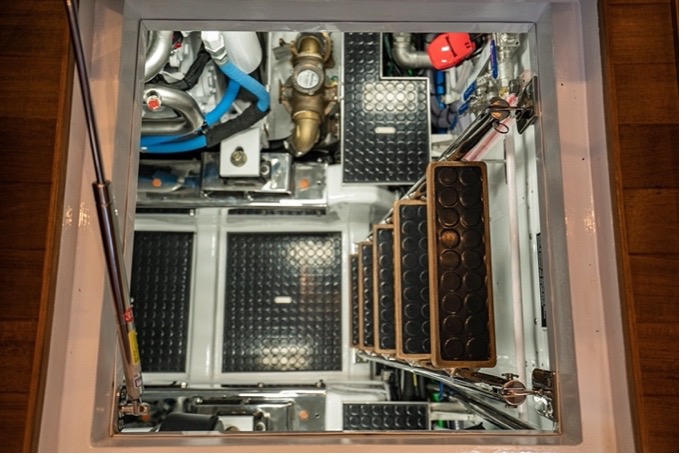
The engines are installed on stainless-steel bearers bedded in chockfast. We are happy to see that the engines connect to Seatorque MM-275 enclosed shaft systems. This expensive system — which we only see on the best-built boats — decouples the mechanical drive system from the marine gear to the shaft, using instead a fluid, thereby greatly reducing prop vibration. The system also ensures that the engines and trannies are not damaged if the props strike the bottom.
Three marine-grade aluminum fuel tanks are painted with epoxy and interconnected. A fuel-manifold system for supply and return has a 2” (5.08 cm) crossover and the tanks have sight gauges. Dual Racor filters with vacuum gauges are used for each engine and the generator has a single one.
Marine-grade bronze is used for thru-hull fittings and they’re all labeled. Groco sea strainers are used for all raw-water intakes for the mains and are plumbed for emergency dewatering using the engines’ water pumps. Even though the boat has six bilge pumps, in a serious emergency, the only pumps that can save a ship are in the engines.
We are particularly impressed by the equipment selection for the operation of the vessel. In virtually all cases, the brands selected are the ones we would choose for our own yacht. By using proven brands with excellent reputations, the builder offers a couple its best guarantee of low maintenance. Then the only question is how well was it installed?

Standard engines on the 54’ Pilothouse are 715-hp Cummins QSM11 engines. Options are higher horsepower, but 1,430 combined hp is enough in our opinion. Every owner has his own parameters of speed and distance for daily runs. A fuel capacity of 1,000 gallons (3,700 L) will provide a long day’s run at relatively high speeds, two days running at mid-teens speeds and a week’s running at displacement speeds.
Fully laden, the vessel should weigh about 70,000 lbs. (31,818 kg), which is relatively light for this type of boat. Lightweight, the boat’s 15’10” (4.82 m) beam and the twin 715-hp diesels should allow her to travel slightly over 20 knots at WOT and cruise comfortably at 17 knots. (We have not tested the boat.) She is semi-displacement, and the builder says she has a deep and fine forefoot for a more comfortable ride.
A 12 kW Northern Lights generator — with sound shield and vibration absorbing mounts — provides electrical power. Some owners might want to upgrade to a 20 kW unit, but if all of the appliances are not run at once, the standard unit should be fine.
Delta-T air induction and demisting systems are installed, along with two exhaust fans. We like this system (which is expensive) because it goes a long way toward keeping moisture out of the engine room. There is a Headhunter 120 V freshwater pressure pump with a backup 12V Headhunter water-pressure pump.
Other excellent features of the engine room include the following: a heavy-duty dog-down engine-room door, freshwater washdown, dual Racor filters on the mains with vacuum gauges, which are quite useful, plus sound absorbing material on the overhead and the forward bulkhead.
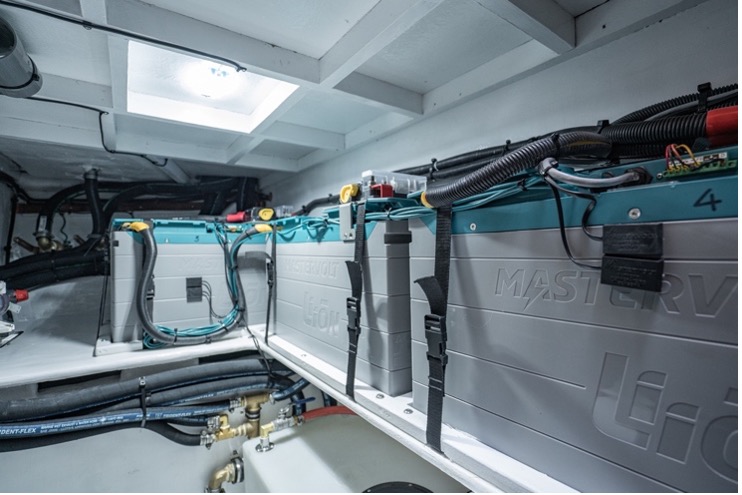
For batteries, the 54’ Pilothouse comes standard with four Lifeline 8D glassmat main engine-start units, one for the generator and six Lifeline 8D glassmat batteries for the ship’s 24-volt system. There’s a crossover for the main engine and generator batteries and an ANG 12.5 KVA 50-amp isolation transformer. A Mastervolt Mass Combi 24/3000, 120/240-volt, 60 Hz inverter-charger with an interface cable and high-temperature shutdown has a remote panel in the pilothouse to control it.
Battery Upgrade. For those that would like to take advantage of a more sophisticated system, all it takes is money. It’s called the “Energy Control Center.” Replace the standard inverter with two Mastervolt 3500W split-system units ($4,375) and add a Mastervolt SCM60 MPPT-MB solar regulator with pre-wiring to the hardtop. Upgrade from the standard AGM batteries to four Mastervolt lithium-ion Ultra 24/5500 with an EasyView 5 monitor ($26,060) and add a second Mastervolt 24/110 house battery charger ($3,170)
Options Worth Considering
- Twin 850-hp MAN i850 with ZF 500 gears/Seatorque MB4-275
- Twin Volvo Penta D13 900s w/ZF 400A gears/Seatorque—Call for Price
- Additional 12kW Northern Lights generator—$32,900
- Additional 9kW Northern Lights generator—$29,500
- Reverso gear-driven oil-change system w/5 ports—$4,695
- Termodinamica minimal amp draw HVAC system—$37,525
- ANG 12.5 KVA 50-amp iso boost isolation transformer in lieu of standard—$5,265
- Teak decking in the cockpit—$11,775
- Teak caprail, no varnish—$9,430
- Stidd 200-500N helm seats on flying bridge—$10,950
- Hydraulic lift for salon table—$1,400
- Solid-wood handrail overhead in the salon—$1,400
- Pelican water purifier—$1,360
Base Price
2024 Retail price with twin 715–hp Cummins QSM11 engines and standard equipment: $2,432,340
Observations
We think that anyone considering a pilothouse type vessel for long-range cruising but thought they couldn’t afford such a vessel should look at the Offshore 54’ Pilothouse. As we have repeatedly pointed out, the equipment installed is excellent and she looks to be a real value proposition. The layout is well thought out and we suspect that the builder will work with an owner on some customization. For example, it has plans for a three-cabin boat and we can think of things to do in the forward cabin that would add utility.
Finally, 50-something feet is a good size compromise between price, livability and good seakeeping.
